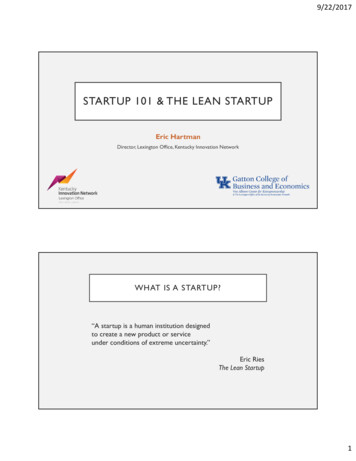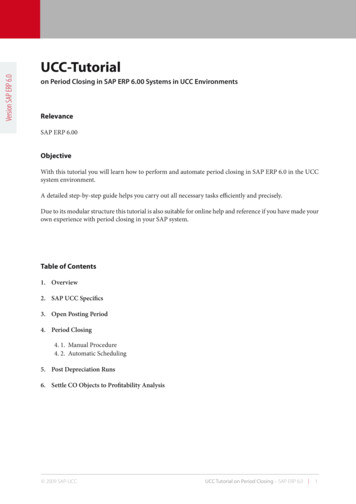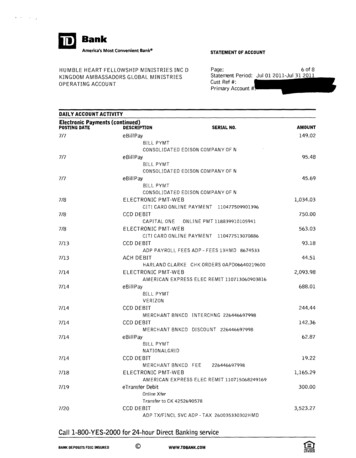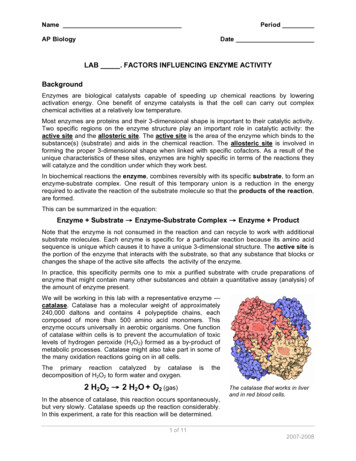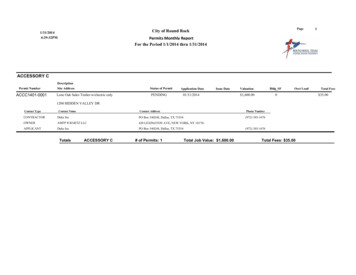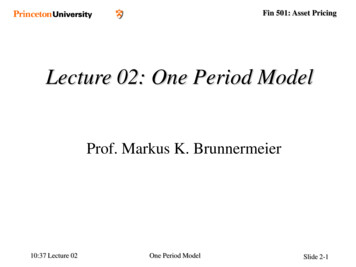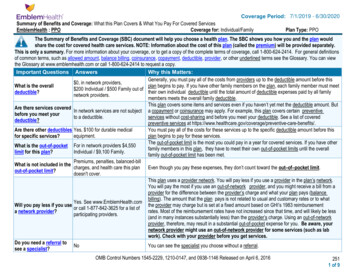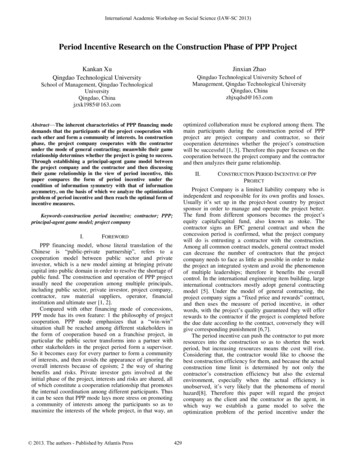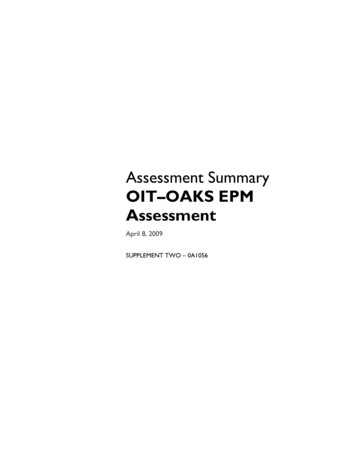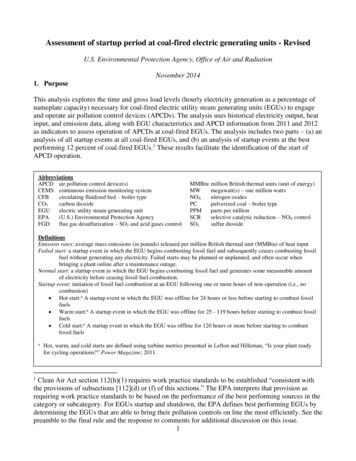
Transcription
Assessment of startup period at coal-fired electric generating units - RevisedU.S. Environmental Protection Agency, Office of Air and RadiationNovember 20141. PurposeThis analysis explores the time and gross load levels (hourly electricity generation as a percentage ofnameplate capacity) necessary for coal-fired electric utility steam generating units (EGUs) to engageand operate air pollution control devices (APCDs). The analysis uses historical electricity output, heatinput, and emission data, along with EGU characteristics and APCD information from 2011 and 2012as indicators to assess operation of APCDs at coal-fired EGUs. The analysis includes two parts – (a) ananalysis of all startup events at all coal-fired EGUs, and (b) an analysis of startup events at the bestperforming 12 percent of coal-fired EGUs.1 These results facilitate the identification of the start ofAPCD operation.AbbreviationsAPCD air pollution control device(s)CEMS continuous emission monitoring systemCFBcirculating fluidized bed – boiler typeCO2carbon dioxideEGUelectric utility steam generating unitEPA(U.S.) Environmental Protection AgencyFGDflue gas desulfurization – SO2 and acid gases controlMMBtuMWNOXPCPPMSCRSO2million British thermal units (unit of energy)megawatt(s) – one million wattsnitrogen oxidespulverized coal – boiler typeparts per millionselective catalytic reduction – NOX controlsulfur dioxideDefinitionsEmission rates: average mass emissions (in pounds) released per million British thermal unit (MMBtu) of heat inputFailed start: a startup event in which the EGU begins combusting fossil fuel and subsequently ceases combusting fossilfuel without generating any electricity. Failed starts may be planned or unplanned, and often occur whenbringing a plant online after a maintenance outage.Normal start: a startup event in which the EGU begins combusting fossil fuel and generates some measurable amountof electricity before ceasing fossil fuel combustion.Startup event: initiation of fossil fuel combustion at an EGU following one or more hours of non-operation (i.e., nocombustion) Hot start:a A startup event in which the EGU was offline for 24 hours or less before starting to combust fossilfuels Warm start:a A startup event in which the EGU was offline for 25 - 119 hours before starting to combust fossilfuels Cold start:a A startup event in which the EGU was offline for 120 hours or more before starting to combustfossil fuelsaHot, warm, and cold starts are defined using turbine metrics presented in Lefton and Hilleman, “Is your plant readyfor cycling operations?” Power Magazine; 2011.Clean Air Act section 112(h)(1) requires work practice standards to be established “consistent withthe provisions of subsections [112](d) or (f) of this sections.” The EPA interprets that provision asrequiring work practice standards to be based on the performance of the best performing sources in thecategory or subcategory. For EGUs startup and shutdown, the EPA defines best performing EGUs bydetermining the EGUs that are able to bring their pollution controls on line the most efficiently. See thepreamble to the final rule and the response to comments for additional discussion on this issue.11
2. IntroductionThe EPA received several comments concerning our definition of the end of startup in response to theproposed reconsideration of startup/shutdown issues for the Mercury and Air Toxics Standards(MATS) Rule. Several commenters advocated that the startup period should not end when the EGUbegins generating electricity or useful thermal energy. Rather, commenters argued that startup shouldend at different times depending on whether the EGU was subcritical or supercritical, and on the typesof controls that were installed. Commenters stated that some APCDs, such as selective catalyticreduction (SCR), need up to 12 hours after electricity generation begins before they becomeoperational. They also stated that circulating fluidized bed (CFB) EGUs become operationally stableonly after they reach approximately 40 percent load.The EPA examined available data concerning the types of EGUs on which the commenters focused:subcritical and supercritical EGUs with flue gas desulfurization (FGD) and SCR controls, and CFBEGUs. This assessment required an hour-by-hour analysis of startup events using emissionmeasurements (from continuous emission monitoring systems (CEMS)), heat input, and electricity(gross) output data from the EPA’s Clean Air Markets Database2 for the types of EGUs identified bythe commenters. Using these data, the EPA calculated the average time, in hours, for specific types ofEGUs to achieve decile and quartile load bins (e.g., 10 percent, 20 percent, and 25 percent ofnameplate capacity) and for SO2 and NOX APCDs to begin reducing SO2 and NOX emission rates,respectively. In addition, the EPA analyzed the time required for emissions to decline at the bestperforming 12 percent of coal-fired EGUs – EGUs that were able to, on an annual average, initiateoperation of their SO2 or NOX APCDs in the least amount of time following the start of generation.The analysis focused on SO2 and NOX emissions because the EPA believes that emissions will besufficiently stable and consistent at this time to accurately measure HAP emissions. In addition, (a)SO2 emissions serve as a surrogate for acid gas hazardous air pollutants (HAP), (b) FGD and SCR canimpact mercury levels3 and the effectiveness of mercury controls, and (c) changes in SO2 and NOXemissions is a measure that can indicate when APCDs are operational. This study does not includeassessments of PM control devices (e.g., baghouses, electrostatic precipitators) because hourly PMdata were not available; however, comments and other information in the record demonstrate that thebest performing EGUs are able to sufficiently warm the PM control devices to operational temperatureon clean fuels alone (i.e., within 1 hour of charging coal to the boiler).This analysis provides information on the startup process and the time required for SO2 and NOXAPCDs to become operational at coal-fired EGUs. While the actual decision of when to initiate anAPCD is affected by a variety of factors, including the type of control device, local weather conditions,flue gas temperature, and safety concerns, this analysis is intended to determine the average timerequired to initiate APCDs at all coal-fired EGUs and also at the best performing coal-fired EGUs. TheEPA believes that the removal efficacy of APCDs, as evidenced by hourly emission rates belowuncontrolled levels, is an appropriate indicator of the time the APCDs are operating and provide anappropriate metric for defining the end of the startup period for the purpose of the MATS rule becausewe are confident HAP emissions can be accurately measured at this time.2The aggregated data set used in this analysis are included in docket ID EPA-HQ-OAR-2009-0234;full data are available from the Clean Air Markets Database [http://ampd.epa.gov/ampd].3Some formulations of catalyst are capable of enhancing the oxidation of mercury, promoting greatercapture by downstream APCDs (e.g., wet scrubbers (FGD)).2
3. Data and methodologyThe EPA collects the emission data analyzed in this paper under 40 CFR Part 75.4 Most fossil fuelfired EGUs report hourly emissions (e.g., SO2, NOX, CO2), stack gas flow, and operations (e.g.,operating time, heat input, gross electricity generation) data on a quarterly basis.5 These data were usedto identify all startup events at 414 subcritical and supercritical EGUs with FGD and/or SCR APCDsand CFB boiler EGUs6 during calendar years 2011 and 2012.This study is intended to assess commenters’ claims that there are performance differences amongcombustion technologies and APCDs as they relate to startup events, and to identify the averagenumber of hours after the start of generation that is necessary to startup SO2 and NOX APCDs at thecoal-fired EGU fleet generally and at the best performing 12 percent of EGUs. In light of thecomments received and to facilitate this assessment, we examined operating data by boiler type (PCsupercritical, PC subcritical, and CFB boilers) and by APCD type. For SO2 emissions, we examinedPC boilers with FGD and CFB EGUs. For NOX emissions, we examined PC supercritical and PCsubcritical boilers with SCR.We excluded cogeneration EGUs from this analysis because adequate steam production data were notavailable. In addition, because the focus of the analysis is on the time it takes to engage the identifiedAPCDs, coal-fired EGUs without FGD and/or SCR APCDs as of January 1, 2011, were excluded fromthe analysis.7 Finally, we excluded data during operating hours with the most conservative substitutedata (i.e., maximum potential concentration, maximum potential flow)8 because these data do notrepresent actual emissions.4Supercritical boiler type is drawn from EIA form 860 and EPA research. The analysis data set notedabove includes this field.5Sources report data at the monitor (stack) level but this study used data apportioned to the EGU. Formore information about Part 75, see the Plain English Guide to the Part 75 Rule atwww.epa.gov/airmarkets/emissions/docs/plain english guide part75 rule.pdf6CFB boiler technologies are capable of controlling SO2 by injecting limestone in the combustion bed.Per the definition of “dry flue gas desulfurization technology” in 40 CFR 63.10042, “[a]lkaline sorbentinjection systems in fluidized bed combustors (FBC) or circulating fluidized bed (CFB) boilers.” areconsidered to be FGD technologies (APCDs).7When a comparison is made between “uncontrolled” and “controlled” EGUs, the uncontrolled datarepresent startup events at EGUs that did not have the relevant APCD. In other words, uncontrolledSO2 emission rates are based on PC EGUs that have installed SCR, and therefore are a part of the dataset, but have not installed an FGD APCD. For NOX, “non-SCR” startup events are based on PC EGUsthat have installed FGD but do not have an SCR. These EGUs may, however, have other NOX controlssuch as low-NOX burners, overfire air, and/or selective non-catalytic reduction APCDs.8Part 75 requires the use of substitute data when a monitor is not working properly or has not beenquality assured. If the monitor is reporting valid emission data for less than 80 percent of operatinghours during the previous 8,760 hours (i.e., one year), substitute data equal to the maximum potentialconcentration or maximum potential flow are applied for any missing data or invalid data. This“conservative” emission value is intended to ensure emissions are not underreported and to create anincentive for EGUs to properly operate, maintain, and quality assure their monitoring equipment andprovide the most accurate and reliable results. ous-factsheet.html3
For purposes of conducting this analysis, we defined a startup event as the initiation of fossil fuelcombustion following one or more hours of non-operation (i.e., no combustion), which is consistentwith the final definition of startup in the MATS reconsideration rule. For each startup event, wecalculated the following values: Number of non-operating hours prior to the startup event (i.e., hours between previouscessation of combustion and start of combustion).Number of hours between start of combustion and start of electricity generation.9Gross electricity generation as a percent of nameplate capacity for each hour following start ofelectricity generation.Emission rates and heat input for each hour after start of combustion and start of electricitygeneration.For the best performing 12 percent of EGUs, 2-hour rolling average emission rates (pounds per millionBritish thermal units, lb/MMBtu) were calculated following the start of generation. A 2-hour averagewas used to smooth out some of the variability inherent during startup4.ResultsDuring calendar years 2011 and 2012, there were 9,719 distinct startup events (see Table 1)10 – 9,467at PC EGUs and 252 at CFB EGUs.Table 1: Number of normal and failed starts by boiler and APCD types, years 2011 and 2012.Boiler-controlNormal starts Failed starts Total startsPC EGU7,3642,1039,467Supercritical w/ FGD1,6123691,981Supercritical w/ SCR1,4133241,737Subcritical w/ FGD4,8271,3356,162Subcritical w/ SCR2,5788233,401CFB EGU20844252The average EGU had between 9 and 10 startup events per year during 2011 – 2012, but data from asmall number of EGUs indicated significantly more startup events (e.g., the EGUs with the moststartup events had over 100 startup events in 2011 and over 80 in 2012.) For the 414 coal-fired EGUsin this analysis, the overall number of startup events remains reasonably consistent across both years.9Reporting instructions for Part 75 allow the use of default megawatt values, typically 1 or 2 MWh,when combustion is underway but gross load is zero. This is typically done for apportioning heat inputamong EGUs sharing a common stack or pipe. Without the default value, the calculation would requiredividing by zero and, therefore, result in an error. For this study, we conservatively set the start ofelectricity generation from the hour where gross load exceeded 2 MWh.10Because startup events are grouped by boiler and control, a startup event may be counted more thanonce. For example, each startup event at a PC EGU with an FGD and SCR would be counted as astartup event at an FGD-equipped EGU and at an SCR-equipped EGU.4
4.1Operations between start of combustion and start of generationWe analyzed emissions and operations data for each startup event from the start of fossil fuelcombustion to the start of electricity generation. Specifically, we examined the length of time an EGUcombusts fossil fuel before initiating electricity generation, giving consideration to the period of timethe EGU was offline and whether or not the EGU successfully initiated electricity generation.Generally, during startup of a coal-fired boiler the
Assessment of startup period at coal-fired electric generating units - Revised U.S. Environmental Protection Agency, Office of Air and Radiation November 2014 1. Purpose This analysis explores the time and gross load levels (hourly electricity generation as a percentage of nameplate capacity) necessary for coal-fired electric utility steam generating units (EGUs) to engage and operate air .
